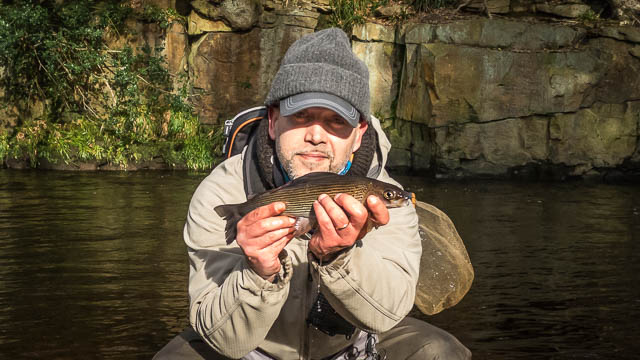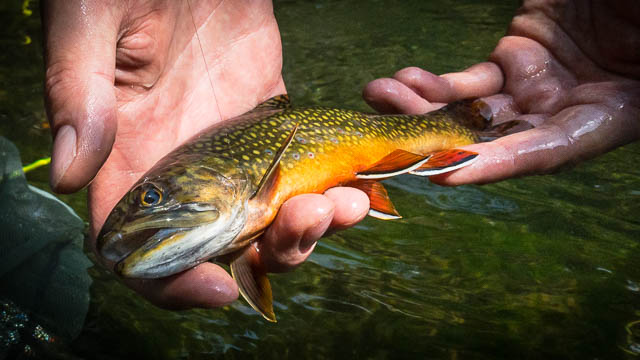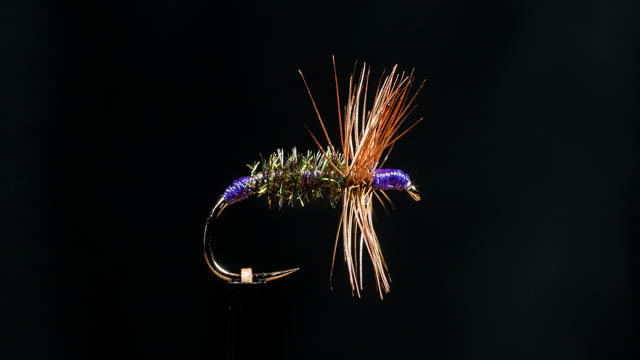Fly Tying Patterns: Video demo & More
Some of the simplest fly tying patterns are also the most effective. John’s video demo in this post shows a brilliant example of that (and as well as being a tremendous trout fly, the hotspot/hot-butt makes it a wonderful autumn grayling fly too). In the post below, I’ve also listed resources that you will find invaluable in creating your own “army” of simple but deadly flies.
Fly tying Patterns: Resources
If you liked this lesson, you can watch more free tying demo videos in our growing library of episodes of “Kebari in Focus”. Just click on
The Episode Archive for Kebari in Focus.
On top of that, you can watch our series of three videos that teach key tying skills, explain the background to our own tying and introduce you to tying our personal deadly dozen fly patterns:
And on top of all that, you can also learn my comprehensive strategy for selecting simple, impressionistic flies for river fishing through three more episodes that introduce the book “How to Fool Fish with Simple Flies”:
Fly Choice in Focus (All Episodes)
By taking advantage of all these resources, you’ll gain huge (and deserved) confidence in the creation and use of our trusted fly tying patterns. You’ll also understand how to design in your own required features to tap into a particular biological loopholes in the feeding behaviour of trout, char and grayling. The fundamental instructions for tying (including the use of the basic tools, catching the thread onto the hook, applying the body materials and hackle plus securely finishing off the fly are ALL given in the free resources.
The range of videos also gives you a nice starting selection of fly patterns to tie and add to your box with confidence. So now all you need are a few tips on how to fish the featured pattern from this page…
Fishing JP’s Hot-spot Pattern
Originally designed as an “out and out” stiff-hackled wet fly (kebari) for tenkara, it is outstanding in this role. Whether used to anchor in opposing currents, dead drift just below the surface, manipulated on or under the surface it scores well in a variety of waters. When fished in peat-stained water the orange hot-spot can be especially effective for trout in the warmer months of the year. Don’t overlook this pattern for autumn grayling fishing though – as it is a terrific combination of trigger features (outline, stiff hackle, peacock herl iridescence and the dual orange hot spots at each end of the body). BUT – this is not the only way that this pattern can be fished…

Adaptable Fly Tying Patterns are Cool
It is very easy to apply some dry fly floatant and tie this on to the tippet attached to a regular fly fishing rig on a fly rod/reel setup with a floating line. The pattern performs great like that – but its uses don’t stop there. You can also fish it as a sub-surface dropper fly (usually combined with a weighted/bead-head point fly). When fished as part of a nymphing rig it is equally at home on a “short line” Czech nymphing setup or as a more classic high-sticking/upstream nymphing approach.

Of course, there can be great advantages to nymph-fishing “spooky” conditions using a French leader – and the pattern shines there too. Any time where you need that splash of orange, combined with the “insecty” peacock iridescence to help fish pick it out it is worth a swim.
Special “Sight Fishing” Tip
The use as a sub-surface “stalking” fly is also mentioned by JP in the video (which is where having the pale underside of the hackle tied so that it faces the angler also helps – because it is easier to see and track below the surface).
Fly Tying Patterns: Effectively Varying the Basic Recipe
The pattern and tying method shown for JP’s orange hot-spot kebari is extremely easy to vary (whether that is by hackle type and colour or simply the tying thread). One of our favourites that we both have a lot of confidence in is the purple thread variation (regular readers of our content will also know that I have a real favourite large “sakasa” version which uses this purple thread and a large, soft hen-pheasant hackle too).

Fly Tying Round-up
I hope that this post (and the supporting links) have given you some inspiration for trying out these fly tying patterns for yourself. All of the flies featured are tried and tested extensively in the field (they are not just “born in the vice”). Every one is a proven fish catcher when used in its sweet spot conditions. The tying instructions that JP has put together are first class I think you’ll agree and I really do urge you to keep an open mind and not fall into the trap of rejecting a fly tying or presentation style just because of what the main “herd” of fly fishers think and say.
Whether you are a rod and reel fly fisher (pleasure or competition), a fixed line fly fisher, a predominantly “Japanese tenkara” practitioner or someone who embraces all these things, the flies and tying methods shown will serve you very well indeed on stream.
Please let me know in the comments of any success stories that you have with the patterns covered (especially the orange and purple hot spot kebari with a stiff ginger hackle).
Also, as ever, please do mash the social share buttons that you see on the page (and if your software has blocked them, do feel free to go ahead and directly share the URL of this page on your social media accounts – we really appreciate the spreading of our message when people find it genuinely useful).
Good luck and Enjoy!
Paul

Nice Pattern! I have tied a similar one by using a single Peacock herl for a size 14 hook and a thread coloured in tan. This pattern I did use for spooky trout and some greylings on the last weekend. What should I say: A terrific Ashtapazuri-Inferno – such an AMAZING day. Fantastic!
Wonderful Eberhard! Great to hear about combining similar kebari with the manipulation tactics shared from Japan.